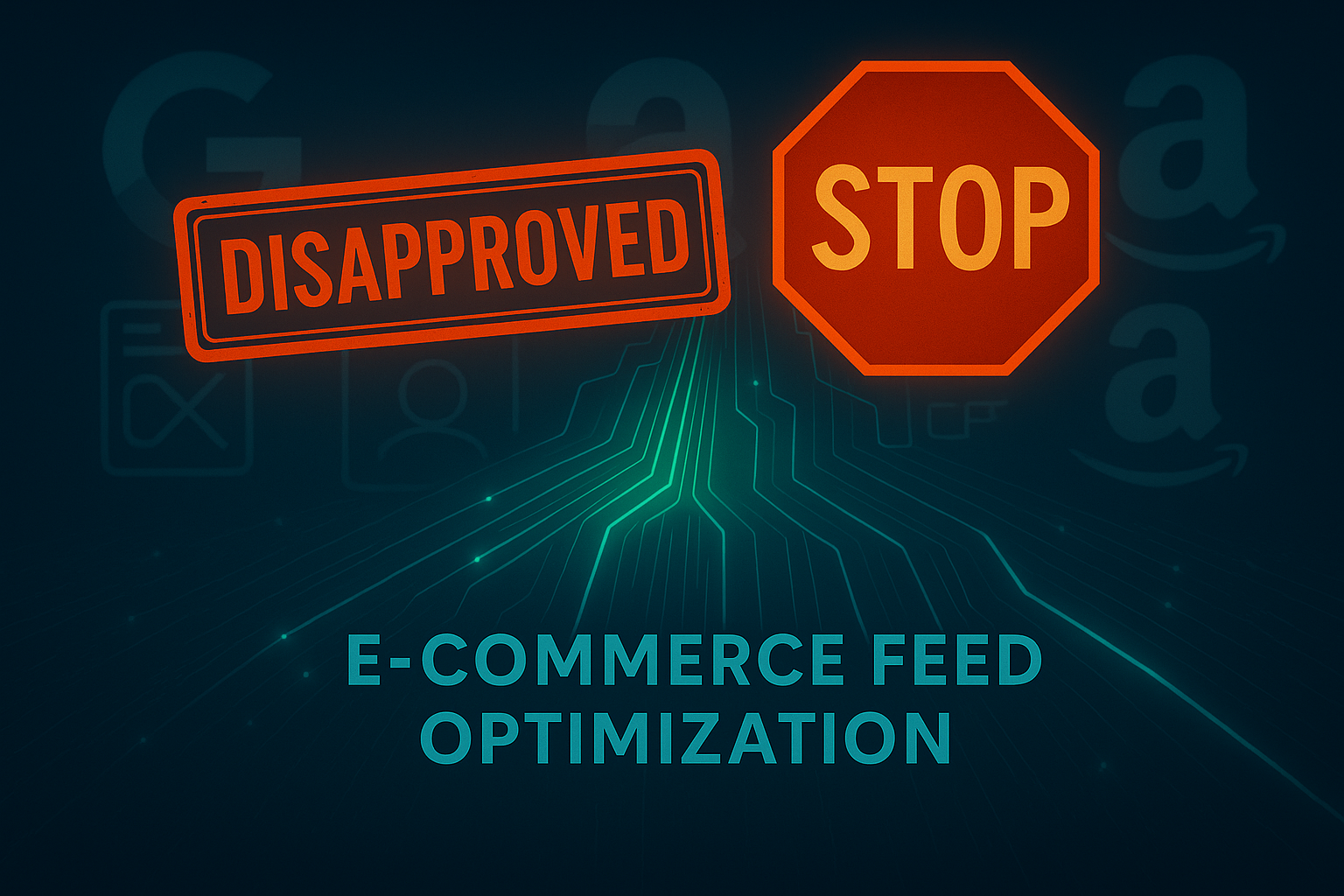Every e-commerce brand operating at a 7-figure level knows the pain: one day your products are flying off the digital shelves, the next your listings are suppressed, your ads are down, and your revenue grinds to a halt. You’re not alone. It’s a critical, high-stakes moment when product feeds run into compliance issues or outright disapprovals across Google Merchant Center, Meta (Facebook), or Amazon.
These aren’t minor glitches. Product disapprovals on Google alone can immediately remove products from Shopping ads and free listings, cutting visibility and sales overnight. Nearly half of all merchants experience some form of policy violation leading to disapprovals — proving how widespread the issue really is.
The real challenge isn’t just fixing a single error; it’s understanding how each platform enforces its rules, diagnosing issues quickly, and preventing them before they happen. You don’t need surface-level advice — you need actionable insight.
At Shopping AI Pro, we’ve been in the trenches. Feed compliance is the foundation of sustainable growth. Handle it wrong, and it’s not just a policy problem — it’s a revenue problem.
The Landscape of Feed Compliance: Google, Facebook, & Amazon
When you sell across multiple platforms, you’re not dealing with one rulebook. Each ecosystem — Google, Meta, and Amazon — has its own approach to accuracy, trust, and enforcement. What’s acceptable on one can get you flagged on another.
Google Merchant Center (GMC): Prioritizes product accuracy, transparency, and user trust. Policies exist to prevent misleading listings and ensure shoppers see what they expect.
Meta Ads (Facebook & Instagram): Focuses on user safety, privacy, and responsible advertising, especially for sensitive categories.
Amazon Seller Central: Enforces strict authenticity and customer-satisfaction standards — its suppression rules protect both buyers and Amazon’s reputation.
The important part: these ecosystems aren’t isolated anymore. The same trust signals — return policies, structured data, site transparency — affect every channel. Build integrity once, and it pays off everywhere.
Google Merchant Center: Diagnosing & Resolving Product Disapprovals
Google Shopping is often a brand’s primary sales driver, which makes GMC disapprovals especially painful. When products vanish, it’s usually because something in the feed or site data doesn’t align with Google’s requirements.
Common Causes and Practical Fixes
Product Identification (MPN & Brand)
Google uses identifiers to verify authenticity. Missing or inconsistent MPN and brand fields make products harder to match and can limit visibility.
→ Ensure every variant has a clean, unique MPN and brand combination.
Image Issues
Low-res, watermarked, or heavily edited images trigger flags.
→ Treat your main image like packaging — it should look legitimate and load reliably. Use clear, unaltered product images without overlays or borders.
Pricing & Availability Mismatches
These are the most common triggers. Even short-term inconsistencies between feed and site can lead to disapprovals.
→ A daily sync is typically sufficient. Just make sure it runs reliably so updates for pricing, stock, or promotions reach Google before discrepancies build up.
Category Accuracy
Generic product categories make it harder for Google to understand what you sell.
→ Use the most specific Google Product Category available, and update when product lines change.
Promotional or Excessive Text
Titles like “FREE SHIPPING!!!” or “BEST DEAL EVER!” look spammy.
→ Keep titles factual and readable. Save promotions for your ad copy, not your product feed.
Unsupported Content or Policy Violations
Google blocks categories like event tickets, motor vehicles, real estate, and services — and closely monitors supplements and regulated products.
→ Check policy eligibility before uploading products.
Misrepresentation
The broadest (and most frustrating) violation. It covers deceptive pricing, unclear checkout terms, or missing business information.
→ Keep your site transparent, secure, and consistent. Show return policies, contact details, and total costs clearly.
Facebook Ad Account: Navigating Deactivations & Policy Violations
Meta’s ad platform is powerful but unforgiving. Automated systems scan every ad and destination for compliance, and a single violation can freeze spend across campaigns.
Common Violation Categories:
- Prohibited content (weapons, adult products, tobacco, illegal goods)
- Misleading or exaggerated claims
- Missing or unclear billing terms in subscription models
- Copyright or trademark misuse
- Suspicious activity (new accounts after bans, payment failures)
If you’re flagged:
→ Review Account Quality in Business Manager to identify the issue.
→ Fix it, then appeal once — concisely, with evidence of the correction.
→ Avoid repeated resubmissions; that lowers trust further.
Transparency and patience work faster than persistence here.
Amazon Product Listings: Fixing Suppressions & Policy Breaches
Amazon suppresses listings that don’t meet its quality or policy standards. This can happen for missing data, inaccurate images, or compliance failures.
Common Causes:
- Incomplete attributes (missing brand, description, or key details)
- Image guideline violations (non-white backgrounds, watermarks, or low resolution)
- Policy breaches (restricted items, counterfeit concerns)
- Safety or certification gaps (especially for toys, health, or electronics)
- Pricing errors or inconsistencies
Resolution Workflow:
- Use Fix Your Products to identify specific issues.
- Check Performance Notifications for enforcement messages.
- For account-level issues, submit a clear Plan of Action (root cause, corrective action, and prevention plan).
Amazon rewards thoroughness — vague or defensive responses rarely work.
Deep Dive: High-Stakes Product Categories
Some products carry more compliance risk than others. Here’s how to handle the most common ones.
Supplements & Health Products
These are heavily scrutinized. The problem isn’t the category itself — it’s unverified claims.
→ Keep listings factual: ingredients, dosage, and benefits in plain language.
→ Avoid “miracle,” “cure,” or “clinically proven” phrasing without verifiable proof.
→ Maintain documentation (COAs, ingredient sourcing, FDA registration if applicable).
Subscription or Auto-Renew Models
Recurring billing attracts instant attention from enforcement systems.
→ Show total cost, renewal terms, and cancellation process clearly before checkout.
→ Avoid “free trial” language unless it’s fully automated and transparent.
Used & Refurbished Items
Clarity is everything.
→ Set the correct “condition” attribute.
→ Show any wear or packaging differences upfront.
Digital Products & Services
Google Shopping limits purely digital goods — but you can still sell them compliantly by bundling them with a physical component.
→ Create a tangible version (e.g., a printed guide, card, or welcome kit) that includes digital access.
→ Clarify delivery and refund terms.
Alcohol, CBD, and Region-Restricted Items
→ Keep targeting localized and age-gated.
→ Use whitelisted or approved categories when available.
→ Expect temporary removals — and plan re-approvals as part of your process.
Proactive Compliance: Preventing Future Disapprovals
The best operators don’t wait for disapprovals — they prevent them with consistent feed discipline and predictable data hygiene.
The Feed Health Playbook
1. Pre-Submission Audits
→ Check identifiers, titles, and links before pushing updates.
2. Continuous Monitoring
→ On Google: review Diagnostics and Item Issues weekly.
→ On Meta: check Account Quality daily.
→ On Amazon: monitor Fix Your Products and Performance Notifications.
3. Sync Frequency Matters
A once-a-day sync is plenty — consistency matters more than speed.
→ Keep the daily run stable and error-free.
→ For fast-moving products, selectively update price or stock mid-day instead of rebuilding the full feed.
4. Feed Automation Without Blind Spots
Automation saves time — but don’t let it hide errors.
→ Use custom mapping for titles, categories, and conditions.
AI as an Early-Warning System
AI should help you prevent issues, not fix them after the fact.
→ Spot recurring disapproval patterns.
→ Predict attribute conflicts before they go live.
→ Flag high-risk listings based on historical enforcement data.
Build Trust Into the Website Foundation
Feed health depends on site credibility.
Clear policies, SSL checkout, and visible contact info reduce review frequency and improve platform trust. Treat these as ranking factors, not legal checkboxes.
The Operator’s Advantage
Proactive compliance compounds.
A stable, predictable feed builds long-term trust — and trust equals uptime.
The goal isn’t perfection. It’s consistency that scales.
Expert FAQs & Community Insights
Google won’t tell me exactly what’s wrong with my account. What do I do?
In most cases, it’s not your feed — it’s your site trust signals.
- Missing or vague contact information
- Hidden or incomplete return/refund policy
- No visible payment methods
- Surprise fees or unclear shipping timelines
- Mismatched business details between site and GMC
Fix those, request a review, and most suspensions lift quickly. Don’t waste time rewriting your feed if the real issue is a missing address.
My Facebook ads keep getting rejected for ‘circumventing systems,’ but I’m not doing anything wrong.
Meta’s detection focuses on behavior patterns, not intent.
→ Avoid duplicate accounts or campaigns after a disapproval.
→ Verify your domain and remove redirect chains.
→ Relaunch one clean ad with fresh assets — that rebuilds trust faster than appeals.
Is there a safe workaround for certain policies?
Not really — but there are smarter structures.
→ Align product data to each platform’s interpretation, not your own.
→ Fix recurring triggers at the template level.
→ Test changes in a staging feed before deploying them live.
The goal isn’t to dodge enforcement — it’s to make your data impossible to misread.
Master Your Feeds, Master Your Revenue
Feed compliance isn’t busywork — it’s the infrastructure behind your entire sales engine.
When your product data, policies, and site trust signals all line up, your visibility compounds. You get fewer disapprovals, faster approvals, and more consistent reach across every major channel.
The brands that thrive in 2025 aren’t guessing what the platforms want — they’re building durable systems that stay compliant and profitable through every update.
At Shopping AI Pro, that’s exactly the philosophy we operate from.
Our Feedzly platform and AI-driven optimization systems aren’t about automation for its own sake — they’re built to protect uptime, accuracy, and profitability.
Whether you’re scaling on Google, Meta, or Amazon, your feed is the single source of truth those systems rely on to trust you.
When you control your feed, you control your revenue.
Ready to ensure your feeds are always compliant and performing at their peak? Let’s discuss how Shopping AI Pro can transform your feed strategy and protect your revenue.



